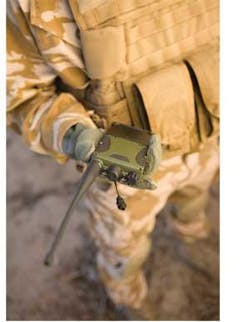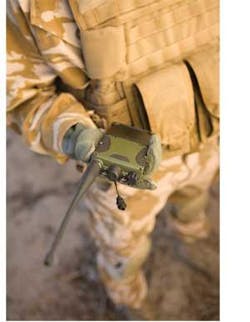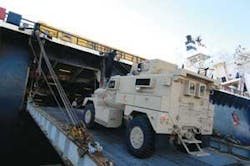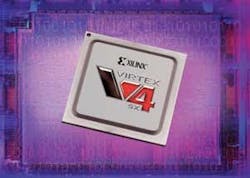By John McHale
Software-defined radio technology, driven by the Joint Tactical Radio System program, is enhancing communications throughout the U.S. military and in civilian and commercial applications worldwide.
Providing warfighters the means to communicate regardless of radio type or frequency used has been the main goal of the U.S. military’s Joint Tactical Radio System (JTRS) from its conception.
That worthy aspiration propelled the development of software-defined radio (SDR) technology—the defining of functionality in radios through software—which will enable soldiers to link not only with old radios using waveforms, such as Single-Channel Ground and Airborne Radio Systems (SINCGARS), but also with communications systems that trade voice, video, and other data.
The JTRS program plans to replace traditional hardware radios with devices that can emulate any radio’s capabilities by simply changing software. Fielded JTRS radios can be upgraded with software via the wireless information network.
Systems with full JTRS capability are still years away from deployment, but SDR technology is already available to the warfighter and is emerging rapidly in public-safety applications and the commercial market.
“Defense spending has certainly advanced SDR,” says Lee Pucker, chief executive officer of the SDR Forum in Phoenix. Nevertheless, this technology is everywhere, “even in the Apple iPhone. People are surprised when I say that.” The iPhone has communication functionality through software.
Today’s SDR technology lacks all the capability that will be standard in future systems, but it meets the basic definition, Pucker adds. SDR technology will see increasing application in cell phones and other communications devices. “Whether it’s TV or video games, it will be delivered through SDR,” Pucker adds.
“We don’t build radios anymore; we build computers that transmit,” says Mark Turner, director of software and secure products engineering for the Harris Corp RF Communications segment in Rochester, N.Y.
“JTRS was ahead of its time with SDR,” Turner says. The good news is that while the U.S. Department of Defense (DOD) was the early adapter, the technology is being pushed into homeland security and commercial applications, which will continue to make SDR systems competitive in price, Turner says. “Moore’s Law applies here too,” he adds.
Analysts at VDC Research Group Inc. in Natick, Mass., echo Turner’s comments. They say the military market—particularly the U.S. military—is still a research-and-development market for SDR and is likely to maintain that posture until 2010 or 2011.
VDC analysts point to two main emerging markets for SDR—military and commercial. VDC analysts released data earlier this year showing the SDR market growing at a 31 percent rate from $2.2 billion in 2006 to nearly $10 billion by 2011.
Technology that was developed through a DOD program is evolving and merging into other applications and markets, Turner says. Eventually, technology developed to enhance SDR in the commercial world will also find its way back to defense applications, he adds.
Driving the commercial market is the deployment of upgradeable wireless infrastructure, VDC analysts say. The commercial sector, which VDC believes to be fundamentally different from the military, has adopted SDR technology in many wireless infrastructure products. Recently announced changes in the definition of SDR by the SDR Forum and the IEEE will formalize many products not previously called SDR, as actually being SDR.
In addition, VDC found this forecasted growth in SDR technology to be driven by the ease of adapting or retrofitting products to or evolving air interface standards; potential margin improvement for OEM equipment manufacturers from developing products on a common hardware delivery platform; and improvements in product development cost and time to market.
The commercial world has many examples of SDR, yet the systems with the most capability reside in the military and not just the JTRS program.
Examples of SDR outside of JTRS but in the defense community include: the Digital Modular Radio from General Dynamics C4 Systems in Scottsdale Ariz.; the Falcon II and III radios from Harris RF; and research-and-development efforts in the European Community, Pucker says.
Digital Modular Radio
The Digital Modular Radio (DMR) replaces several legacy radios with one system on board various U.S. Navy surface ships and submarines. General Dynamics won another $23 million contract from the Navy this summer for more DMRs. General Dynamics is also one of the prime contractors on the JTRS program.
The system replaces 14 racks of legacy radios with one system; on certain platforms it can reduce equipment space requirements by more than 50 percent. The software-defined DMRs communicate with ultra-high frequency SATCOM, SINCGARS, line-of-sight, and high-frequency radios. Deliveries on the contract are scheduled to begin in mid-2009 and continue though 2010.
DMR is deployed on several Navy attack submarines, aircraft carriers, destroyers, and one amphibious transport dock. The first deployment was in 2004 aboard the guided missile destroyer USS Chung-Hoon.
The system is controlled, either locally or across the network, by a user-friendly Windows-based human-machine interface. The DMR system integrates RF communications from 2 MHz to 2 GHz, security, peripheral control, ancillaries, computing, and networking into one system. This open-architecture technology helps the Navy switch to its IT21 FORCEnet vision of network-centric warfare.
The General Dynamics Wireless Information Transfer System (WITS) technology led to the development of the U.S. Navy’s DMR set. About 750 software-defined channels capable of 2 MHz to 2 GHz operation have been delivered.
“By replacing what used to be racks of radios and encryption equipment, one DMR represents considerable savings in size, weight, and power to the Navy,” says Chris Brady, vice president of assured communications for General Dynamics C4 Systems. “The expertise we’ve gained from executing on the DMR program is particularly relevant as we work with Lockheed Martin in the development of the Airborne and Maritime/Fixed Station component of the Joint Tactical Radio System.”
The DMR contracting office is the Space and Naval Warfare Systems Command, working on behalf of the Navy’s program executive office for command, control, communications, computers, and intelligence in San Diego.
Harris Falcon II and III radios
While DMR brings SDR capability to Navy platforms, the Falcon line of radios from Harris RF is delivering SDR capability to U.S. ground forces. The Falcon II is one of the best-selling radios in the world, deployed to ground forces worldwide, including Iraq and Afghanistan, says Harris RF spokesman Ben Rand.
One Falcon II application is in mine-resistant ambush-protected vehicles or MRAPs, Rand says. “It is accurate to state that we have installed about 10,000 radio systems in MRAP vehicles made by all the services—Army, Navy, Air Force, and Marines.”
The next-generation Falcon III also is being deployed rapidly in military applications, such as the Marine’s Tactical Handheld Radio (THHR) procurement program, Rand says, adding that the U.S. Marine Corps is upgrading its 8TS communications with the Falcon III AN/PRC-152, handheld and AN/VRC-110 vehicular radios.
The Falcon II and III are software-defined radios; the difference is the Falcon III is based on the JTRS specification and JTRS Software Communications Architecture (SCA), says Turner.
Meeting a standard such as the SCA makes it easier to manage product life cycle and add capability down the road, Turner says. The Falcon III is also certified to National Security Agency (NSA) interoperability standards, he adds.
According to the Harris data sheet, the Falcon III AN/PRC-117G(V)1 is one channel radio that covers 30 MHz to 2 GHz and is 30 percent smaller and 35 percent lighter than the fielded multiband manpack radios.
It is “the first and only radio to receive Type-1 certification for voice and data,” Rand says. “The 117G is a combined wideband/narrowband radio, meaning it provides CNR voice, but also data-intensive applications, such as streaming video.”
The radio provides SINCGARS, Havequick II, VHF/UHF AM and FM, High-Performance Waveform (HPW), MIL-STD-188-181B SATCOM, and the Harris Adaptive Networking Wideband Waveform (ANW2). Future planned software upgrades include the DAMA, IW, SATURN, and APCO P25 waveforms—subject to NSA approval.
The Harris ANW2 is similar to the Soldier Radio Waveform (SRW) being developed for JTRS, Turner says. Harris created ANW2 so that when the SRW is ready, it will be easy to adapt it, he explains.
“We developed both Falcon radios in house, investing our own dollars,” Turner says. Working within a program cycle with the DOD would take many years; by developing SDR radios in-house that meet JTRS specifications, Harris was able to get radios in the field more quickly.
The process is similar to what the DOD does with a spiral contract. They get one version into the field, manage the lifecycle costs, and gain valuable lessons learned from the field, Turner says. Capabilities are easily added because it is done through software, which also keeps obsolescence costs down, he adds.
When you can get technology into the soldiers’ hands quickly it helps evaluate whether it is the right technology for the right requirement at the right time, Turner says.
The Falcon III radios provide extended frequency range, significant reductions in weight and size, waveform upgradeability, and programmable encryption. In addition to SINCGARS capabilities, Falcon III radios provide UHF line-of-sight communications, close-air support and tactical satellite communications, and programmable encryption. Encryption is important because adding waveforms without security kind of “defeats the purpose,” Turner says.
Harris has also added a line of public-safety radios called Unity, Rand says. The first product released was the Unity XG-100 multiband portable land mobile radio.
According to the Harris release, it provides secure interoperable communications over public-safety frequency bands from 136 to 870 MHz, which would enable emergency personnel to communicate directly without carrying several radios or route transmissions through ad-hoc network bridges. The radio complies with the APCO Project 25 technical standard in conventional and trunking modes and is about the same size as fielded single-banded radios.
While some public-safety applications may use Falcons, they are too expensive for most uses in that sector, Turner says. The Unity family is more affordable, he adds.Falcons are rugged and designed to be dropped from helicopters, “which makes them cost-prohibitive” for some homeland-security applications,” Turner says.
Situational awareness is just as important in public safety as it is in military networks, Turner says. Soldiers need to know where other troops and deployed units are just as first responders in hurricane disaster areas need a clear picture of where police, fire, and emergency services are located, he continues.
Europe and SDR
The European Community is pushing SDR adaptation as well, but does not have the JTRS specifications driving it, Pucker says. Establishing those standards based on JTRS and the SCA is the first step the European Defense Agency (EDA) needs to take—for military and civilian applications, says Manuel Uhm, director of wireless communications for Xilinx in San Jose, Calif.
There are different waveforms used in Europe, but the SCA will still apply, Uhm says. The common European waveforms are the STANAG variants from the North Atlantic Treaty Organization (NATO), he says. STANAG is how NATO abbreviates standardization agreement.
Despite the later start, the Europeans are at an advantage because they can learn from the DOD’s mistakes, especially with the business model, which continues to evolve, Uhm says.
The DOD has faced some intellectual property rights issues in waveform development; some companies will not share their waveforms. To use their waveforms, users must buy their system, which goes against the philosophy of the JTRS procurement model, he explains.
Uhm declined to name specific companies, but says it is being worked out. Key European programs pushing SDR technology include the European Secured Software-defined Radio Referential (ESSOR) and WINTSEC (Wireless INTeroperability for SECurity) project, Uhm says.
According to the SDR Forum, the EDA approved a three-year investment program focused on the research and development of secure wireless communication and is studying longer-term SDR requirements.
ESSOR is one of those programs and is aimed at enhancing interoperability of national SDR projects, Uhm says. WINTSEC explores a mixture of complementary solutions to overcome the barriers for wireless interoperability across different security agencies, enabling first responders with incompatible legacy radios to communicate in a crisis situation, say officials from Spectrum Signal Processing in Burnaby, British Columbia.
The European Commission Joint Research Center (JRC) Sensors Radar Technologies and Cyber Security Unit (SERAC) is using Spectrum’s flexComm Waveform Design Studio for the research and development of SDR capability in WINTSEC.
“The JRC is focused on solving some critical public-safety communications challenges in Europe,” says Mark Briggs, vice president of marketing at Spectrum. “The Waveform Design Studio provides an integrated &lsquoIF to Ethernet’ solution with complete run-time software, including a licensed Software Communications Architecture software stack, a suite of development tools, system examples, and sample applications.”
The JRC will be using Spectrum’s technology to support a possible improvement of European Union communications interoperability in the area of security and first responders; to enhance understanding of emerging technologies, mesh networks, and wideband communications; and to better assess future threats to critical network infrastructures.
SDR is essential to defense community and the EDA is addressing it, but in spite of all the technological progress the willingness to deploy SDR in civilian or military space is not there yet, says Jorge Pereira, principal scientific officer for the European Commission. “Technological evolution and current capabilities are, in most cases, well ahead of the willingness to deploy.”
Pereira made his comments during the SDR Forum Workshop, “Government and Industry R&D Agendas for Next Generation Radio,” held last October in Boston. His presentation was titled “Trends, Drivers, Challenges, and Potential of Software-Defined/Reconfigurable Radio.”
Pereira says business models are not enough and the technology needs to be driven through to enable better communication for emergency and disaster management. Pereira says he sees a need to deploy several systems, such as WiFi and WiMax.
For emergency management, easily deployable IP wireless ad-hoc networks are needed in the absence of infrastructure, Pereira says. This means a scalable, reconfigurable, reliable, and secure system introducing ad-hoc adaptations and reusing current WLAN standards, he continues.
“The problem is not only one of technology, it is more of perception, maybe as a result of the early hype,” Pereira says. However, trends “will facilitate a move towards reconfigurable/software-defined solutions.”
JTRS program overview
The U.S military’s Joint Tactical Radio System (JTRS) program provides networked communications on the move and at the tactical edge to support information sharing and combat readiness,” says Howard Pace during a presentation at the Military & Aerospace Electronics Forum earlier this year in San Diego.
Pace is the Deputy Joint Program Executive Officer for the JTRS Joint Program Executive Office in San Diego.
“The program achieves interoperability through a common set of shared open system standards and applications, as well as “cost savings via an open enterprise business model,” Pace told forum attendees.
Under this model, the program’s Consolidated Interim Single-Channel Handheld Radio (CISCHR) contract “returned more than $130 million to the services through competitive cost savings,” Pace says. The JTRS program office is working a similar contract strategy for manpack radios, he added.
Pace broke down the program into three domains—Ground, Airborne/Maritime, and Network.
Under the ground domain, JTRS is developing a Ground Mobile Radio (GMR), which will support networking requirements for Army and Marine Corps ground vehicular platforms; and Handheld, Manpack, and Small Form Fit Radios (HMS), which will support requirements for JTRS Handheld and Manpack units and forms suitable for integration into platforms requiring a small form fit radio, Pace says.
“JTRS is also awarding several competitive awards for consolidating services’ near-term needs for single-channel, JTRS-approved handheld radios,” he added.
Under the Network Enterprise Domain (NED), JTRS will develop network and legacy waveforms and provide network enterprise services, Pace says.
The Multifunctional Information Distribution System (MIDS) is also under this domain and migrates “the current MIDS-Low Volume Terminal (LVT) to JTRS compliance producing the next-generation data link and communication terminal for joint and coalition tactical platforms,” he continued.
The Airborne Maritime/Fixed Site (AMF) “supports requirements for airborne (including rotary wing), maritime, and fixed station platforms for all services,” Pace says.
Encryption at chip level key in military SDR application
Software-defined radio (SDR) systems bring many capabilities to end users in military and commercial applications. However, those capabilities lose their luster if the information transmitted is not secure because the data is intercepted or the software code is tainted.
Security is a huge issue, says Lee Pucker, chief executive officer of the SDR Forum in Phoenix. Enabling high assurance is about encrypting and authenticating data. Just as software certification aids in authentication issues, encryption is needed to prevent attacks or intercepts of data.
Engineers at Xilinx are focusing on improving encryption in SDR applications through their field-programmable gate arrays (FPGAs), says Manuel Uhm, director of wireless communications at Xilinx in San Jose, Calif. “Our main place in the JTRS community is encryption, specifically single-chip encryption,” Uhm says. For more detail, Uhm referenced a white paper titled “FPGA-based Single-Chip Cryptographic Solution.” It was written by Mark McLean of the National Security Agency (NSA) in Baltimore and Jason Moore of Xilinx in Albuquerque, N.M.
“The use of FPGAs in Type I Cryptographic equipment has historically been limited,” McLean and Moore write. “While FPGA use is allowed, restrictions on how they are used can result in inefficient processing and an increase in system size, weight, and power. For example, redundancy and isolation of functionality is required through physically separate devices.
Their paper discussed technology that used the Xilinx Virtex 4 FPGA as “a single-chip cryptographic solution.”
The technology involves a design flow and verification process based on NSA requirements for high-grade cryptographic processing. Xilinx and the NSA performed an isolation analysis against the NSA Fail Safe Design Assurance (FSDA) specifications, and an exhaustive vulnerability assessment, which enabled the two entities to develop the technology, McLean and Moore state.
The complexity and density level of the” Virtex 4 would seem to preclude any efficient isolation analysis,” McLean and Moore state. “However, Xilinx FPGAs are modular devices. No matter which device is chosen, they consist of the same basic building blocks tiled over and over again.” Therefore, the authors focused on two of those elements—the configurable logic block (CLB) and a global switch matrix (GSM), used for interconnect that is common for all features in the FPGA. The “isolation analysis focused on an exhaustive review of the CLB and GSM.”
In addition to the isolation analysis, a thorough security analysis was required before a device could be used in a U.S. cryptosystem, McLean and Moore write. “This analysis is conducted to determine the level-of-effort required by an adversary to exploit the device. As a result of the analysis, strategies can be developed and deployed to mitigate discovered vulnerabilities.
“It is preferable to develop a system using parts that require a higher level-of-effort to attack, as this increases the overall difficulty of exploiting the system,” McLean and Moore continue. “The actual results of the evaluation are classified” and are “available from NSA with the proper clearance and a valid need-to-know.”
Because of the high-security requirement, a security monitor in the form of an IP core was “developed to be implemented within the Virtex 4 fabric to further enhance security,” McLean and Moore state. The monitor handles all security-related functions for the device.”
It also removes the “burden of physical security requirements from the system designers and allows them to concentrate more on their particular application,” the authors continue. “The security monitor will be embedded into all designs processing sensitive data.”
The NSA found the Virtex 4—when used in conjunction with the security monitor—“to be an architecture capable of processing classified information and maintaining a high level of security,” McLean and Moore state.








